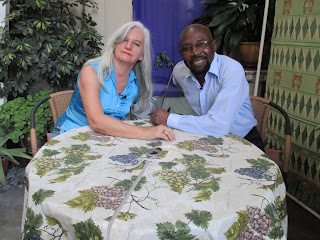(my trip to Lima, Peru - continued)
Before going, I’d made plans
to meet with the people I was planning to film.
I’d also made contact with others who would provide me with information
to deepen my awareness about Afro-Peruvian culture and its performance
traditions.
On my first day after
arriving, I did a lot of walking to see where I was located, and check out
places to eat and purchase groceries. I
found that my apartment was near the lovely Parque Kennedy (Kennedy Park), as
well as a supermarket (where I purchased an inexpensive cell phone), and a
string of small bars where you could get a decent-to-good meal at a decent
price.
 |
| Parque Kennedy |
 |
| Bars along calle Berlin. |
An aside here: before going, I’d been told not to drink tap
water or even the wonderful juices that are prepared with fruit pulp thinned by
tap water. Of course the first thing I
did in the first little bar I went to was order one of those juices, completely
forgetting the advice. Halfway through,
I remembered it and stopped drinking. I
suffered no ill effects and throughout my stay, gradually increased the amount
of tap water I drank until I got to the point that I could forget the
advice.
Since different stomachs
acculturate in different ways, my experience may or may not be what others will
encounter.
On my second full day in
Lima, I went to meet Lalo Izquierdo, one of the main subjects of both of the
documentaries I was working on. We
arranged to meet in downtown Lima, in an area near the city center.
 |
| Me with Lalo Izquierdo in the patio of the apartment where I was staying. |
Rather than taking a taxi, I
decided to take the bus. There was a bus
stop near my apartment and everyone was very helpful in advising me which bus to
take.
But the line for my bus was,
well, seemingly endless. The buses
themselves were very large, but still did not have nearly enough capacity for
the number of people who wanted to get on.
A helpful gentleman told me
that because of my obvious age (I’m well over 50), I could get at the head of
the line. Almost never in my life have I
taken advantage, or wanted to take advantage, of my “senior” status, but one
look at that line was enough to convince me it was time to make an exception.
When I got on the bus, there
was no seating but since I don’t look frail, no one offered me a seat. This was no problem; I am in fact pretty sturdy.
 |
| Lots of people in a park for an event; there were generally lots of people everywhere. |
But the result of this bus
ride, and the ride back (after having a pleasant and productive meeting with
Lalo) was to clue me into something I continued noticing for much of my
trip: the infrastructure in Lima is
overwhelmed by the population. It is a
city of a little over 7 million people, about a quarter of the population of
the entire country, and a large percentage of these people have only moved into
the city in the past one or two decades.
Other evidence of this was
the sad state of much of the housing in the immense outlying districts. I learned that there are a lot of squatters both
in Lima and in the countryside who don’t have the means to build themselves
good housing (or even to purchase any vacant land).
In the countryside, I’ve
been told that under certain circumstances you become the owner of land on
which you have squatted (like the homesteading laws in the United States) but
often, people build a very rudimentary house in, say, a semi-desert or desert
area (there are huge stretches of desert along the coast of Peru) and then find
it too difficult to live there, so they move along to another place, leaving
the house – or shack – behind them.
In Lima itself, there are
thousands of poorly constructed houses in areas that don’t look like they get
too much civic attention. I’m guessing
that the inhabitants are people who do NOT spend a lot of time in the beautiful
parks along the seashore. I would have
liked to have investigated some of these areas, including Rimac, but just
didn’t have time. Other than Miraflores,
and a couple of bus rides, all I saw of metropolitan Lima was a bit of Barranco
(an area where I’m told there are a lot of writers and artists). I never even saw the main square of downtown
Lima.
PHOTO
And I hate to say it, but
this kind of ends my experience in Lima.
I’ll write another article
about my time visits to the coastal area both north and south of Lima.









































